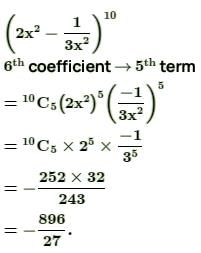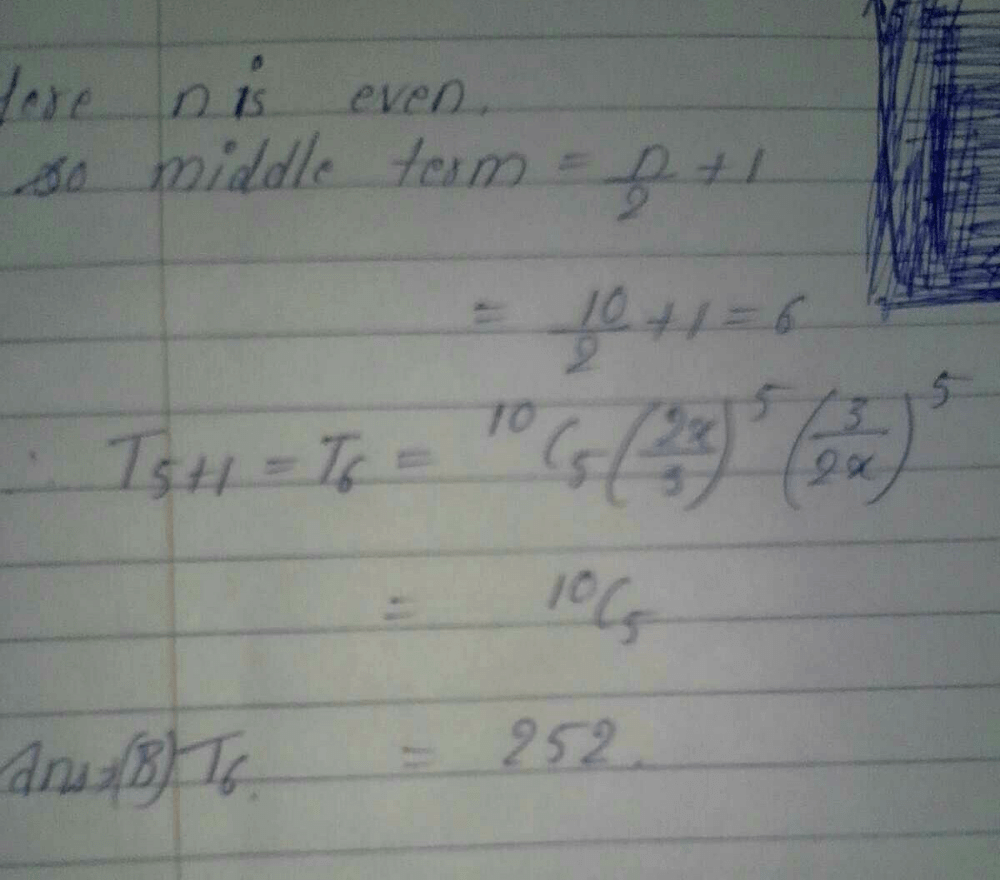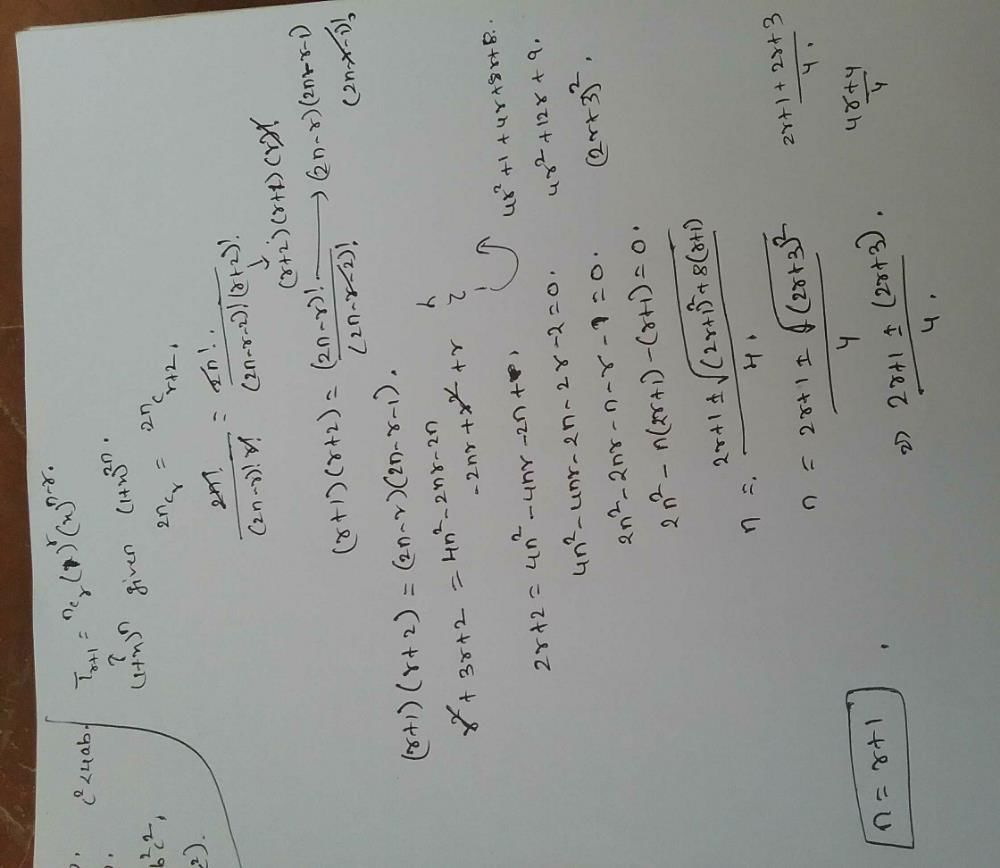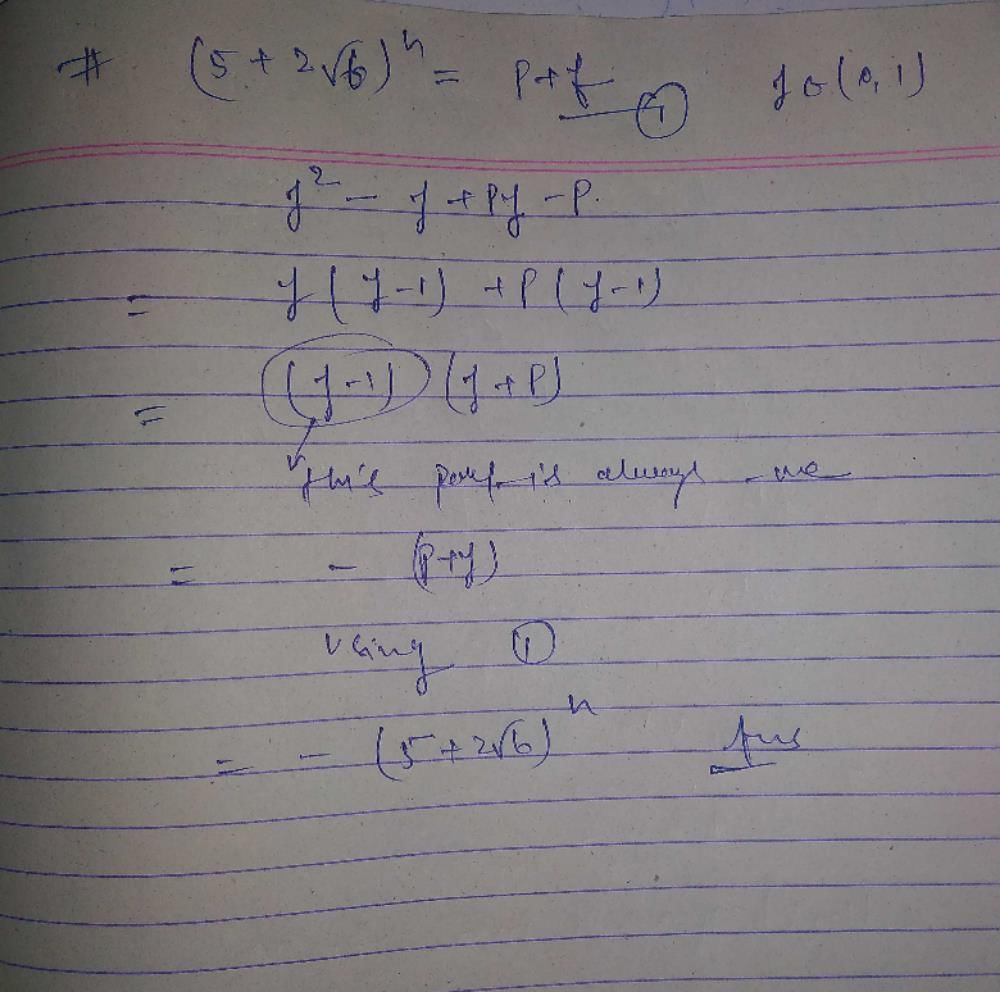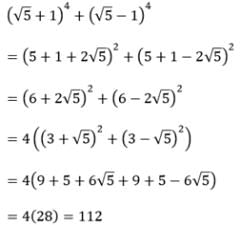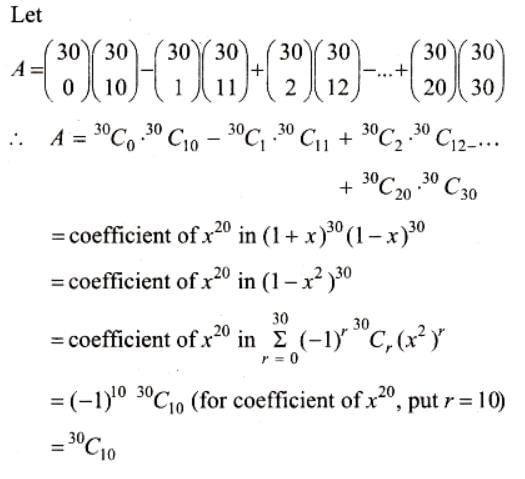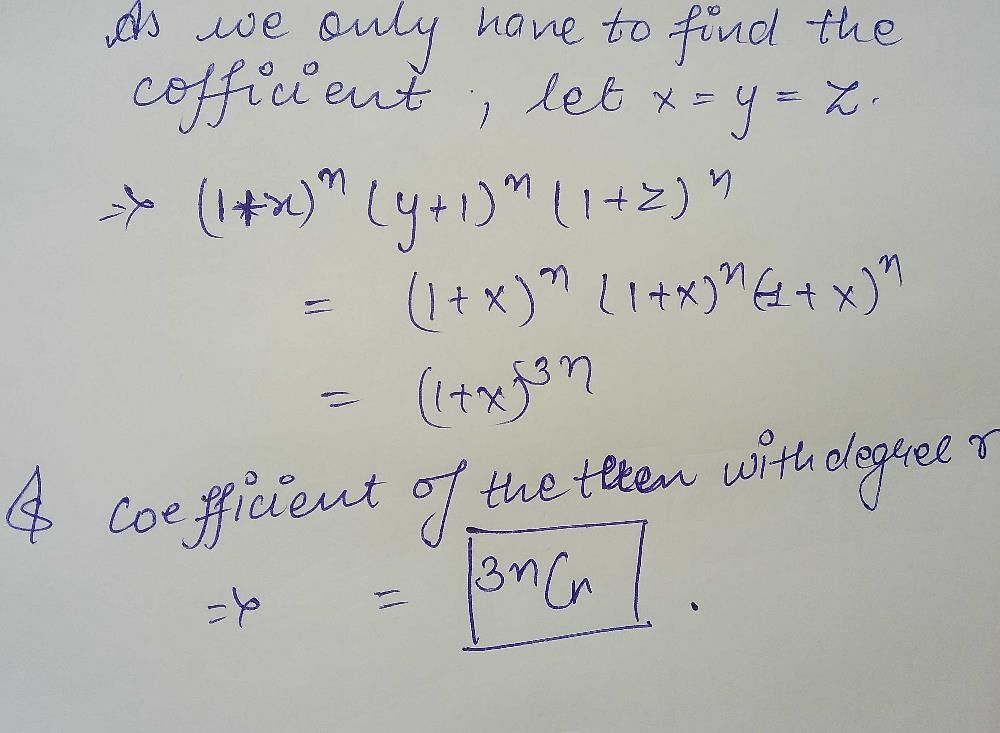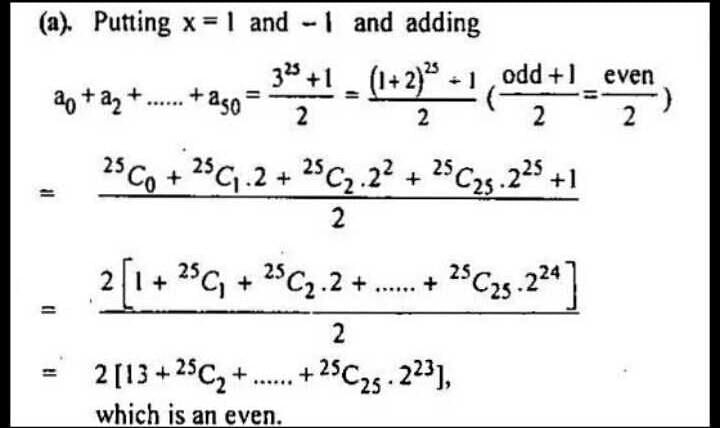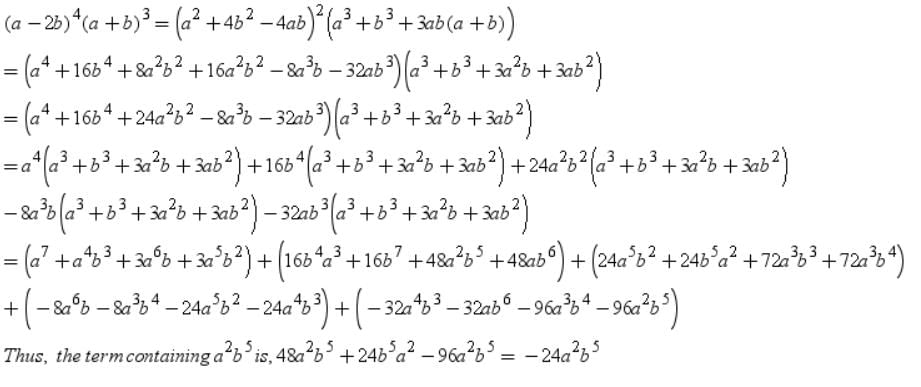All Exams >
JEE >
Chapter-wise Tests for JEE Main & Advanced >
All Questions
All questions of Binomial Theorem & its Simple Applications for JEE Exam
In the expansion of the binomial expansion (a + b)n, which of the following is incorrect ?
- a)The exponent of a decreases from n to 0.
- b)The number of terms is n+1.
- c)The exponent of b increases from 0 to n.
- d)The binomial coefficients in (a+b)n, which are equidistant from beginning and end are not equal.
Correct answer is option 'D'. Can you explain this answer?
In the expansion of the binomial expansion (a + b)n, which of the following is incorrect ?
a)
The exponent of a decreases from n to 0.
b)
The number of terms is n+1.
c)
The exponent of b increases from 0 to n.
d)
The binomial coefficients in (a+b)n, which are equidistant from beginning and end are not equal.
|
|
Krishna Iyer answered |
Correct Answer: d
Explanation:- The coefficient of terms (x+a)n equidistant from the beginning and the end are equal. These coefficients are known as the binomial coefficients.
nCr = nCn – r, r = 0,1,2,…,n.
The middle term in the expansion of (x + y)10 is the- a)6th term
- b)5th term
- c)average of 5th and 6th terms
- d)7th term
Correct answer is option 'A'. Can you explain this answer?
The middle term in the expansion of (x + y)10 is the
a)
6th term
b)
5th term
c)
average of 5th and 6th terms
d)
7th term
|
|
Vikas Kapoor answered |
Number of terms(n) = 10
Middle term = (n/2) + 1
Middle term = (n/2) + 1
= (10/2) + 1
= 5 + 1
= 6th term
= 5 + 1
= 6th term
The largest coefficient in the expansion of (1+x)24 is:- a)24C13
- b)24C12
- c)24C11
- d)24C24
Correct answer is option 'B'. Can you explain this answer?
The largest coefficient in the expansion of (1+x)24 is:
a)
24C13
b)
24C12
c)
24C11
d)
24C
24

|
Manish Aggarwal answered |
Largest coefficient in the expansion of (1+x)24
= 24C24/2
= 24C12
= 24C24/2
= 24C12
The middle term in the expansion of (1 – 2x + x2)n is - a)

- b)

- c)

- d)

Correct answer is option 'B'. Can you explain this answer?
The middle term in the expansion of (1 – 2x + x2)n is
a)
b)
c)
d)
|
|
Om Desai answered |
Here 2n is even integer, therefore,
term will be the middle term.
Now, ( n + 1)th term in (1-x)2n = 2nCn(1)2n-n(-x)n = 2nCn(-x)n

The number of terms in the expansion of (x – y + 2z)7 are:- a)35
- b)38
- c)36
- d)37
Correct answer is option 'C'. Can you explain this answer?
The number of terms in the expansion of (x – y + 2z)7 are:
a)
35
b)
38
c)
36
d)
37
|
|
Tejas Verma answered |
Here the number of terms can be calculated by:
= ((n+ 1) * (n+2)) /2
where, n =7
= ((n+ 1) * (n+2)) /2
where, n =7
∴ Number of terms = 36
The number of terms in the expansion of (2x - 3y)8 is- a)6
- b)9
- c)8
- d)5
Correct answer is option 'B'. Can you explain this answer?
The number of terms in the expansion of (2x - 3y)8 is
a)
6
b)
9
c)
8
d)
5
|
|
Aryan Khanna answered |
Since this binomial is to the power 8, there will be nine terms in the expansion.
The sum  equals
equals - a)nCr+1
- b)n+1Cr+1
- c)n+1Cr-1
- d)n+1Cr
Correct answer is option 'B'. Can you explain this answer?
The sum  equals
equals
a)
nCr+1
b)
n+1Cr+1
c)
n+1Cr-1
d)
n+1Cr
|
|
Ishan Choudhury answered |
C(n, r) + c(n -1, r) + C(n - 2, r) + . . . + C(r, r)
= r+1Cr+1 + r+1Cr + r+2Cr + . . . . + n-1Cr + nCr
= n+1Cr+1 (applying same rule again and again)
(∴ nCr + nCr-1 = n+1Cr)
= r+1Cr+1 + r+1Cr + r+2Cr + . . . . + n-1Cr + nCr
= n+1Cr+1 (applying same rule again and again)
(∴ nCr + nCr-1 = n+1Cr)
If 'a' be the sum of the odd terms & 'b' the sum of the even terms in the expansion of (1+x)n, then (1–x2)n equals- a)a2 – b2
- b)a2 + b2
- c)b2 – a2
- d)None
Correct answer is option 'A'. Can you explain this answer?
If 'a' be the sum of the odd terms & 'b' the sum of the even terms in the expansion of (1+x)n, then (1–x2)n equals
a)
a2 – b2
b)
a2 + b2
c)
b2 – a2
d)
None
|
|
Riya Banerjee answered |
Sum of odd terms in the expansion of (1+x)n will be 2(n-1) ....(i)
Now
(1−x2)n = nC0 − nC1 x2 + nC2 x4 + ....(−1)n nCn x2n .....(n)
(1+x2)n = nC0 + nC1 x2 + nC2 x4 +... nCn x2n .....(m)
Subtracting n from m, we get
(1+x2)n − (1−x2)n = 2[nC1 x2 + nC3 x6 + .....]
Now let x=1.
Hence we get
2n − 0 = 2[nC1 + nC3 + .....]
Or nC1 + nC3x2 + nC5 + ... = 2(n-1)
Hence a = b
Now (1−x2)n
=(1+x)n (1−x)n
→[(a+b)(a−b)]
=a2 − b2.
Now
(1−x2)n = nC0 − nC1 x2 + nC2 x4 + ....(−1)n nCn x2n .....(n)
(1+x2)n = nC0 + nC1 x2 + nC2 x4 +... nCn x2n .....(m)
Subtracting n from m, we get
(1+x2)n − (1−x2)n = 2[nC1 x2 + nC3 x6 + .....]
Now let x=1.
Hence we get
2n − 0 = 2[nC1 + nC3 + .....]
Or nC1 + nC3x2 + nC5 + ... = 2(n-1)
Hence a = b
Now (1−x2)n
=(1+x)n (1−x)n
→[(a+b)(a−b)]
=a2 − b2.
In the expansion of (a+b)n, nN the number of terms is:- a)n + 1
- b)n
- c)n – 1
- d)an
Correct answer is option 'A'. Can you explain this answer?
In the expansion of (a+b)n, nN the number of terms is:
a)
n + 1
b)
n
c)
n – 1
d)
an
|
|
Tanishq Saini answered |
Explanation:
Binomial Expansion:
In the expansion of (a+b)^n, where n is a positive integer, the number of terms in the expansion is (n+1).
Proof:
When we expand (a+b)^n using binomial theorem, the general term of the expansion is given by:
T(r+1) = nCr * a^(n-r) * b^r
where r is the index of the term and nCr represents the binomial coefficient.
Number of Terms:
To find the number of terms in the expansion, we need to find the values of r that satisfy 0 ≤ r ≤ n.
Counting the Terms:
- When r = 0, we get the first term: nC0 * a^n * b^0 = a^n
- When r = 1, we get the second term: nC1 * a^(n-1) * b^1
- ...
- When r = n, we get the (n+1)th term: nCn * a^0 * b^n = b^n
Total Number of Terms:
Since we have considered all values of r from 0 to n, there are (n+1) terms in the expansion of (a+b)^n.
Therefore, the correct answer is option A) n + 1.
Binomial Expansion:
In the expansion of (a+b)^n, where n is a positive integer, the number of terms in the expansion is (n+1).
Proof:
When we expand (a+b)^n using binomial theorem, the general term of the expansion is given by:
T(r+1) = nCr * a^(n-r) * b^r
where r is the index of the term and nCr represents the binomial coefficient.
Number of Terms:
To find the number of terms in the expansion, we need to find the values of r that satisfy 0 ≤ r ≤ n.
Counting the Terms:
- When r = 0, we get the first term: nC0 * a^n * b^0 = a^n
- When r = 1, we get the second term: nC1 * a^(n-1) * b^1
- ...
- When r = n, we get the (n+1)th term: nCn * a^0 * b^n = b^n
Total Number of Terms:
Since we have considered all values of r from 0 to n, there are (n+1) terms in the expansion of (a+b)^n.
Therefore, the correct answer is option A) n + 1.
The expansion of  , in powers of x, is valid if
, in powers of x, is valid if- a)|x| > 2
- b)x < 2
- c)x > 2
- d)|x| < 2
Correct answer is option 'D'. Can you explain this answer?
The expansion of  , in powers of x, is valid if
, in powers of x, is valid if
a)
|x| > 2
b)
x < 2
c)
x > 2
d)
|x| < 2

|
Knowledge Hub answered |
In case of negative or fractional power, expansion (1+x)^n is valid only when |x| < 1
(6 - 3x)-1/2
= (6-1/2 (1 - x/2)-1/2)
So, this equation exists only when |x/2| < 1
|x| < 2
(6 - 3x)-1/2
= (6-1/2 (1 - x/2)-1/2)
So, this equation exists only when |x/2| < 1
|x| < 2
If n is a +ve integer, then the binomial coefficients equidistant from the beginning and the end in the expansion of (x+a)n are- a)additive inverse of each other
- b)multiplicative inverse of each other
- c)equal
- d)nothing can be said
Correct answer is option 'C'. Can you explain this answer?
If n is a +ve integer, then the binomial coefficients equidistant from the beginning and the end in the expansion of (x+a)n are
a)
additive inverse of each other
b)
multiplicative inverse of each other
c)
equal
d)
nothing can be said
|
|
Hansa Sharma answered |
(x+a)n = nC0 xn + nC1 x(n-1) a1 + nC2 x(n-2) a2 + ..........+ nC(n-1) xa(n-1) + nCn an
Now, nC0 = nCn, nC1 = nCn-1, nC2 = nCn-2,........
therefore, nCr = nCn-r
The binomial coefficients equidistant from the beginning and the end in the expansion of (x+a)n are equal.
Now, nC0 = nCn, nC1 = nCn-1, nC2 = nCn-2,........
therefore, nCr = nCn-r
The binomial coefficients equidistant from the beginning and the end in the expansion of (x+a)n are equal.
The value of 1261/3 upto three decimals is- a)5.013
- b)5.014
- c)5.012
- d)5.011
Correct answer is option 'A'. Can you explain this answer?
The value of 1261/3 upto three decimals is
a)
5.013
b)
5.014
c)
5.012
d)
5.011
|
|
Lavanya Menon answered |
(126)11/3
= (125 + 1)1/3
= [125 (1 + (1/125))]1/3
= 1251/3(1 + (1/125))1/3 1/125 < 1
= 5 [1 + (1/3)(1/125) + ..........]
= 5 [1 + (1/3)(0.008)]
= 5 [1 + 0.002666]
= 5.013
= (125 + 1)1/3
= [125 (1 + (1/125))]1/3
= 1251/3(1 + (1/125))1/3 1/125 < 1
= 5 [1 + (1/3)(1/125) + ..........]
= 5 [1 + (1/3)(0.008)]
= 5 [1 + 0.002666]
= 5.013

- a)

- b)

- c)610
- d)

Correct answer is option 'D'. Can you explain this answer?
a)
b)
c)
610
d)
|
|
Om Desai answered |
(1- x+2x2)10 = a0+a1x+a2x2 +..a19x19 + a20x20
Replacing x by-x, (1+x+ 2x2)10 = a0 - 1x+a2x2...a19x19 +a20x20)
Subtracting and putting x = 1, 210 - 410 = 2(a1 +a3 +...+a19)
⇒
Replacing x by-x, (1+x+ 2x2)10 = a0 - 1x+a2x2...a19x19 +a20x20)
Subtracting and putting x = 1, 210 - 410 = 2(a1 +a3 +...+a19)
⇒

the coefficient of xn in the expansion of 
- a)n
- b)2n
- c)4n
- d)zero
Correct answer is option 'C'. Can you explain this answer?
the coefficient of xn in the expansion of 
a)
n
b)
2n
c)
4n
d)
zero
|
|
Suresh Reddy answered |
[(1+x)/(1−x)]2
⇒ (1+x)2(1−x)-2
⇒ (1 + x2 + 2x)[1 + 2x + 3x2 +..... +(n−1)xn-2 + nxn-1 + (n+1)xn +...]
coeff of xn will be given by
(I) When 1 will be multiplied by (n+1)xn
(II) When x2 will be multiplied by (n−1)xn-1
(III) When 2x will be multiplied by nxn-1
∴ coeff. of xn = n + 1 + n − 1 + 2n
= 4n
⇒ (1+x)2(1−x)-2
⇒ (1 + x2 + 2x)[1 + 2x + 3x2 +..... +(n−1)xn-2 + nxn-1 + (n+1)xn +...]
coeff of xn will be given by
(I) When 1 will be multiplied by (n+1)xn
(II) When x2 will be multiplied by (n−1)xn-1
(III) When 2x will be multiplied by nxn-1
∴ coeff. of xn = n + 1 + n − 1 + 2n
= 4n
The coefficient of y in the expansion of (y² + c/y)5 is - a)10c
- b)10c²
- c)10c³
- d)None of these
Correct answer is option 'C'. Can you explain this answer?
The coefficient of y in the expansion of (y² + c/y)5 is
a)
10c
b)
10c²
c)
10c³
d)
None of these
|
|
Varun Kapoor answered |
Given, binomial expression is (y² + c / y)5
Now, Tr+1 = 5Cr × (y²)5-r × (c / y)r
= 5Cr × y10-3r × Cr
Now, 10 – 3r = 1
⇒ 3r = 9
⇒ r = 3
So, the coefficient of y = 5C3 × c³ = 10c³
Now, Tr+1 = 5Cr × (y²)5-r × (c / y)r
= 5Cr × y10-3r × Cr
Now, 10 – 3r = 1
⇒ 3r = 9
⇒ r = 3
So, the coefficient of y = 5C3 × c³ = 10c³
Let n be a positive integer. Then of the following, the greatest term is- a)

- b)

- c)

- d)

Correct answer is option 'A'. Can you explain this answer?
Let n be a positive integer. Then of the following, the greatest term is
a)
b)
c)
d)
|
|
Neha Joshi answered |
i)(1+1/4n)4n
= (1+1/4)4
= (5/4)4 = 625/256
ii)(1+1/3n)3n
= (1+1/3)3
= (4/3)3 = 64/27
iii)(1+1/2n)2n
=(1+1/2)2 = (3/2)2
= 6/4 = 3/2
iv)(1+1/n)n
=(1+1)1 = 2
= (1+1/4)4
= (5/4)4 = 625/256
ii)(1+1/3n)3n
= (1+1/3)3
= (4/3)3 = 64/27
iii)(1+1/2n)2n
=(1+1/2)2 = (3/2)2
= 6/4 = 3/2
iv)(1+1/n)n
=(1+1)1 = 2
The number of dissimilar terms in the expansion of (a + b + c)2n+1 – (a + b – c)2n+1 is- a)(n + 1)2
- b)(n – 1)2
- c)4n2 – 1
- d)none of these
Correct answer is option 'A'. Can you explain this answer?
The number of dissimilar terms in the expansion of (a + b + c)2n+1 – (a + b – c)2n+1 is
a)
(n + 1)2
b)
(n – 1)2
c)
4n2 – 1
d)
none of these
|
|
Vikas Kapoor answered |
Given expansion



Number of dissimilar term = (2n + 1) + (2n -1) + ....(2n - 3) + .... + 5 + 3 + 1




Number of dissimilar term = (2n + 1) + (2n -1) + ....(2n - 3) + .... + 5 + 3 + 1
In a Binomial Distribution, if p, q and n are probability of success, failure and number of trials respectively then variance is given by- a)np
- b)npq
- c)np2q
- d)npq2
Correct answer is option 'B'. Can you explain this answer?
In a Binomial Distribution, if p, q and n are probability of success, failure and number of trials respectively then variance is given by
a)
np
b)
npq
c)
np2q
d)
npq2

|
Mehul Chavan answered |
For a discrete probability function, the variance is given by

Where µ is the mean, substitute P(x)=nCx px q(n-x) in the above equation and put µ = np to obtain
V = npq
Where µ is the mean, substitute P(x)=nCx px q(n-x) in the above equation and put µ = np to obtain
V = npq
What is the coefficient of x5 in the expansion of (1-x)-6 ?- a)252
- b)250
- c)-252
- d)251
Correct answer is option 'A'. Can you explain this answer?
What is the coefficient of x5 in the expansion of (1-x)-6 ?
a)
252
b)
250
c)
-252
d)
251
|
|
Preeti Iyer answered |
(1-x)-6
=> (1-x)(-6/1)
It is in the form of (1-x)(-p/q), p =6, q=1
=> (1-x)(-6/1)
It is in the form of (1-x)(-p/q), p =6, q=1
(1-x)(-p/q) = 1+p/1!(x/q)1 + p(p+q)/2!(x/q)2 + p(p+q)(p+2q)/3!(x/q)3 + p(p+q)(p+2q)(p+3q)/4!(x/q)4........
= 1+6/1!(x/1)1 + 6(7)/2!(x/1)2 + 6(7)(8)/3!(x/1)3 + 6(7)(8)(9)/4!(x/1)4 +.......................
So, coefficient of x5 is (6*7*8*9*10)/120
= 252
= 252
If in the expansion of (1+x)20, the coefficients of rth and (r+4)th terms are equal, then the value of r is equal to:- a)9
- b)7
- c)10
- d)8
Correct answer is option 'A'. Can you explain this answer?
If in the expansion of (1+x)20, the coefficients of rth and (r+4)th terms are equal, then the value of r is equal to:
a)
9
b)
7
c)
10
d)
8
|
|
Raghav Bansal answered |
Coefficients of the rth and (r+4)th terms in the given expansion are Cr−120 and 20Cr+3.
Here,Cr−120 = 20Cr+3
⇒ r−1+r+3 = 20
[∵ if nCx = nCy ⇒ x = y or x+y = n]
Here,Cr−120 = 20Cr+3
⇒ r−1+r+3 = 20
[∵ if nCx = nCy ⇒ x = y or x+y = n]
⇒ r = 2 or 2r = 18
⇒ r = 9
⇒ r = 9
What is the general term in the expansion of (2y-4x)44?- a)

- b)

- c)

- d)

Correct answer is option 'A'. Can you explain this answer?
What is the general term in the expansion of (2y-4x)44?
a)
b)
c)
d)
|
|
Om Desai answered |
n = 44, p = 2y q = -4x
General term of (p+q)n is given by
T(r+1) = nCr . pr . q(n-r)
= 44Cr . (2y)r . (-4x)(44-r)
General term of (p+q)n is given by
T(r+1) = nCr . pr . q(n-r)
= 44Cr . (2y)r . (-4x)(44-r)
The coefficient of x4 in the expansion of (1 + x + x2 + x3)n is:
- a)nC4 + nC2
- b)nC4 + nC2+ nC4.nC2
- c)nC4 + nC2+ nC1.nC2
- d)nC4
Correct answer is option 'C'. Can you explain this answer?
The coefficient of x4 in the expansion of (1 + x + x2 + x3)n is:
a)
nC4 + nC2
b)
nC4 + nC2+ nC4.nC2
c)
nC4 + nC2+ nC1.nC2
d)
nC4
|
|
Gaurav Kumar answered |
x4 can be achieved in the following ways:
x4 . 1(n-4) . (x2)0 . (x3)0
Hence, coefficient will be nC4 .
x2 . 1(n-3) . (x2)1 . (x3)0
Hence, coefficient will be 3nC3.
x1 . 1(n-2) . (x2)0 . (x3)1
Hence, coefficient will be 2nC2.
x0 . 1(n-2) .(x2)2 .(x3)0
Hence, coefficient will be nC2 .
Hence, the required coefficient will be
nC4 + 3nC3 + 3nC2
= nC4 + 3(nC3 + nC2).
= nC4 + 3(n+1C3).
= nC4 + nC2 + nC1 . nC2
x4 . 1(n-4) . (x2)0 . (x3)0
Hence, coefficient will be nC4 .
x2 . 1(n-3) . (x2)1 . (x3)0
Hence, coefficient will be 3nC3.
x1 . 1(n-2) . (x2)0 . (x3)1
Hence, coefficient will be 2nC2.
x0 . 1(n-2) .(x2)2 .(x3)0
Hence, coefficient will be nC2 .
Hence, the required coefficient will be
nC4 + 3nC3 + 3nC2
= nC4 + 3(nC3 + nC2).
= nC4 + 3(n+1C3).
= nC4 + nC2 + nC1 . nC2
Which of the following is divisible by 25:- a)6n - 5n + 1
- b)6n + 5n
- c)6n - 5n
- d)6n - 5n - 1
Correct answer is option 'D'. Can you explain this answer?
Which of the following is divisible by 25:
a)
6n - 5n + 1
b)
6n + 5n
c)
6n - 5n
d)
6n - 5n - 1
|
|
Riya Banerjee answered |
we can write (6ⁿ ) = (1 + 5)ⁿ
we know, according to binomial theorem,
(1 + x)ⁿ = 1 + nx + n(n-1)x²/2! + n(n-1)(n-2)x³/3! +.............∞ use this here,
(6)ⁿ = (1 + 5)ⁿ = 1 + 5n + n(n-1)5²/2! + n(n-1)(n-2)5³/3! +...........∞
= 1 + 5n + 5²{ n(n-1)/2! + n(n-1)(n-2)5/3! +.......∞}
Let P = n(n-1)/2! + n(n-1)(n-2)5/3! +.........∞
6ⁿ = 1 + 5n + 25P
6ⁿ - 5n = 1 + 25P -------(1)
but we know, according to Euclid algorithm ,
dividend = divisor × quotient + remainder ---(2)
compare eqn (1) to (2)
we observed that 6ⁿ -5 n always leaves the remainder 1 when divided by 25
we know, according to binomial theorem,
(1 + x)ⁿ = 1 + nx + n(n-1)x²/2! + n(n-1)(n-2)x³/3! +.............∞ use this here,
(6)ⁿ = (1 + 5)ⁿ = 1 + 5n + n(n-1)5²/2! + n(n-1)(n-2)5³/3! +...........∞
= 1 + 5n + 5²{ n(n-1)/2! + n(n-1)(n-2)5/3! +.......∞}
Let P = n(n-1)/2! + n(n-1)(n-2)5/3! +.........∞
6ⁿ = 1 + 5n + 25P
6ⁿ - 5n = 1 + 25P -------(1)
but we know, according to Euclid algorithm ,
dividend = divisor × quotient + remainder ---(2)
compare eqn (1) to (2)
we observed that 6ⁿ -5 n always leaves the remainder 1 when divided by 25
If the coefficients of x7 & x8 in the expansion of  are equal, then the value of n is
are equal, then the value of n is- a)15
- b)45
- c)55
- d)56
Correct answer is option 'C'. Can you explain this answer?
If the coefficients of x7 & x8 in the expansion of  are equal, then the value of n is
are equal, then the value of n is
a)
15
b)
45
c)
55
d)
56
|
|
Ananya Das answered |
Since Tr + 1 = nCr an – r xr in expansion of (a + x)n,
Therefore,
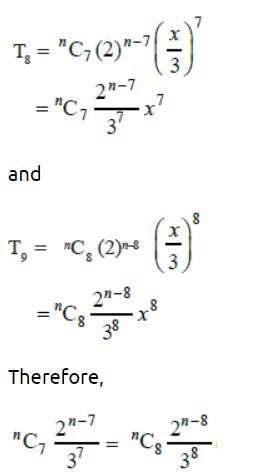
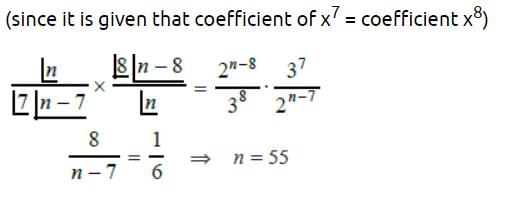
Therefore,


The general term in the expansion of (a - b)n is- a)Tr+1 = (-1)r nCr an-r br
- b)Tr+1 = nCr an-r br
- c)Tr+1 = nCr ar br
- d)Tr+1 = (-1)r nCr ar br
Correct answer is option 'A'. Can you explain this answer?
The general term in the expansion of (a - b)n is
a)
Tr+1 = (-1)r nCr an-r br
b)
Tr+1 = nCr an-r br
c)
Tr+1 = nCr ar br
d)
Tr+1 = (-1)r nCr ar br
|
|
Poonam Reddy answered |
If a and b are real numbers and n is a positive integer, then:
(a - b)n = nC0 an + nC1 a(n – 1) b1 + nC2 a(n – 2) b2+ ...... + nCr a(n – r) br+ ... + nCnbn,
(a - b)n = nC0 an + nC1 a(n – 1) b1 + nC2 a(n – 2) b2+ ...... + nCr a(n – r) br+ ... + nCnbn,
The general term or (r + 1)th term in the expansion is given by:
Tr + 1 = (-1)Cr a(n–r) br
Tr + 1 = (-1)Cr a(n–r) br
If 2nd, 3rd and 4th terms in the expansion of (x+a)n are 240, 720 and 1080 respectively, then the value of n is- a)15
- b)20
- c)5
- d)10
Correct answer is option 'C'. Can you explain this answer?
If 2nd, 3rd and 4th terms in the expansion of (x+a)n are 240, 720 and 1080 respectively, then the value of n is
a)
15
b)
20
c)
5
d)
10

|
Shiksha Academy answered |
General term Tr+1 of (x+y)n is given by
Tr+1 = nCr xn-r yr
T2 = nC2 xn-2 y = 240
T3 = nC3 xn-3 y2 = 720
T4 = nC4 xn-4 y3 = 1080
T3/T2 = [(n-1)/2] * [y/x] = 3......(1)
T4/T2 = {[(n-1)(n-2)]/(3*2)} * x2/y2 = 9/2
T4/T3 = [(n-2)/3] * [y/x] = 3/2...(2)
Dividing 1 by 2
[(n-1)/2] * [3/(n-2)] = 2
⇒ 3n−3 = 4n−8
⇒ 5 = n
Tr+1 = nCr xn-r yr
T2 = nC2 xn-2 y = 240
T3 = nC3 xn-3 y2 = 720
T4 = nC4 xn-4 y3 = 1080
T3/T2 = [(n-1)/2] * [y/x] = 3......(1)
T4/T2 = {[(n-1)(n-2)]/(3*2)} * x2/y2 = 9/2
T4/T3 = [(n-2)/3] * [y/x] = 3/2...(2)
Dividing 1 by 2
[(n-1)/2] * [3/(n-2)] = 2
⇒ 3n−3 = 4n−8
⇒ 5 = n
n-1Cr = (k2 - 3). nCr + 1 [JEE 2004 (Scr.)]- a)

- b)

- c)

- d)

Correct answer is option 'D'. Can you explain this answer?
n-1Cr = (k2 - 3). nCr + 1 [JEE 2004 (Scr.)]
a)
b)
c)
d)
|
|
Rohit Jain answered |
(n - 1)!/{r! × (n - 1 - r)!} = (k² - 3) × n!/(r + 1)!(n - r - 1)!
or, (n - 1)!/r! = (k² - 3) × n!/(r + 1)!
or, (n - 1)!/r! = (k² - 3) × n(n - 1)!/(r + 1)r!
or, 1/1 = (k² - 3) × n/(r + 1)
or, (r + 1)/n = (k² - 3)
we know, r and n are integers so, (r + 1)/n (0, 1]
so, 0 < (r + 1)/n ≤ 1
or, 0 < k² - 3 ≤ 1
or, 3 < k² ≤ 4
or, √3 < k ≤ 2 , -2 ≤ k < -√3
hence, k (√3, 2]
or, (n - 1)!/r! = (k² - 3) × n!/(r + 1)!
or, (n - 1)!/r! = (k² - 3) × n(n - 1)!/(r + 1)r!
or, 1/1 = (k² - 3) × n/(r + 1)
or, (r + 1)/n = (k² - 3)
we know, r and n are integers so, (r + 1)/n (0, 1]
so, 0 < (r + 1)/n ≤ 1
or, 0 < k² - 3 ≤ 1
or, 3 < k² ≤ 4
or, √3 < k ≤ 2 , -2 ≤ k < -√3
hence, k (√3, 2]
The coefficient of x3 in the binomial expansion of 
- a)792m5
- b)942m7
- c)330m4
- d)792m6
Correct answer is option 'C'. Can you explain this answer?
The coefficient of x3 in the binomial expansion of 
a)
792m5
b)
942m7
c)
330m4
d)
792m6
|
|
Geetika Shah answered |
T(r+1) = 11Cr x(11-2r) (m/r)r (-1)r
= 11Cr x(11-2r) mr (-1)r
Coefficient of x3 = 11 - 2r = 3
8 = 2r
r = 4
T5 = 11C4 x3 m4 (-1)
Coefficient of x3 = 11C4 m4
= 330 m4
= 11Cr x(11-2r) mr (-1)r
Coefficient of x3 = 11 - 2r = 3
8 = 2r
r = 4
T5 = 11C4 x3 m4 (-1)
Coefficient of x3 = 11C4 m4
= 330 m4
The total number of 9 digit numbers which have all different digits is- a)9.9!
- b)10!
- c)10P9
- d)99
Correct answer is option 'A'. Can you explain this answer?
The total number of 9 digit numbers which have all different digits is
a)
9.9!
b)
10!
c)
10P9
d)
99
|
|
Geetika Shah answered |
Total number of digits =10
i.e. 0,1,2,3,4,5,6,7,8,9
require 9 diffrent number
0 cant be placed in first place
= first place can be filled in 9 ways
and the rest 9 blank with 9 digits in 9! ways
total ways = 9×9!
i.e. 0,1,2,3,4,5,6,7,8,9
require 9 diffrent number
0 cant be placed in first place
= first place can be filled in 9 ways
and the rest 9 blank with 9 digits in 9! ways
total ways = 9×9!
Fractional part of 
- a)2/31
- b)4/31
- c)8/31
- d)10/31
Correct answer is option 'C'. Can you explain this answer?
Fractional part of 
a)
2/31
b)
4/31
c)
8/31
d)
10/31
|
|
Aryan Khanna answered |

= 8(1+31)15 = 8{15C0 + 15C131+..+15C15(31)15}
278 = 8 + an integer multiple of 31;
The coefficient of x17 in the expansion of (x- 1) (x- 2) …..(x – 18) is- a)- 171
- b)342
- c)171/2
- d)684
Correct answer is option 'A'. Can you explain this answer?
The coefficient of x17 in the expansion of (x- 1) (x- 2) …..(x – 18) is
a)
- 171
b)
342
c)
171/2
d)
684

|
Infinity Academy answered |
The coefficient of x17 is given by
−1 + (−2) + (−3) + ….. (−18)
= −1 − 2 − 3….. − 18
= − (18(18+1))/2
= − 9(19)
= − 171
−1 + (−2) + (−3) + ….. (−18)
= −1 − 2 − 3….. − 18
= − (18(18+1))/2
= − 9(19)
= − 171
(a) Coefficient of t24 in the expansion of (1 + t2)12 (1 + t12) (1 + t24) is [JEE 2003 (Scr.), 3](b) Prove that : [JEE 2003 (Mains),2]
[JEE 2003 (Mains),2]- a)12C6 + 2
- b)12C6+1
- c) 12C6
- d)None
Correct answer is option 'A'. Can you explain this answer?
(a) Coefficient of t24 in the expansion of (1 + t2)12 (1 + t12) (1 + t24) is [JEE 2003 (Scr.), 3]
(b) Prove that :
a)
12C6 + 2
b)
12C6+1
c)
12C6
d)
None
|
|
Om Desai answered |
(1+x)12 (1+x12) (1+x24)
= [C0 + C1x2 + C2x4 + C3x6 + C4x8 +.......C12x24) (1 + x12 + x24 + x36)
= x24(12C0 + 12C6 + 12C12)
= 1 + 12C6 + 1
= 12C6 + 2
= [C0 + C1x2 + C2x4 + C3x6 + C4x8 +.......C12x24) (1 + x12 + x24 + x36)
= x24(12C0 + 12C6 + 12C12)
= 1 + 12C6 + 1
= 12C6 + 2
In the expansion of (1+x)60, the sum of coefficients of odd powers of x is- a)261
- b)260
- c)259
- d)none of these.
Correct answer is option 'C'. Can you explain this answer?
In the expansion of (1+x)60, the sum of coefficients of odd powers of x is
a)
261
b)
260
c)
2
59
d)
none of these.
|
|
Mohit Mittal answered |
C is correct as
sum of ( 1+ x )^60 gives 2^60 which includes both even and odd powers of x
so for only one type of power ( odd power) of x we divide 2^ 60 by 2 so we get 2^ 59
sum of ( 1+ x )^60 gives 2^60 which includes both even and odd powers of x
so for only one type of power ( odd power) of x we divide 2^ 60 by 2 so we get 2^ 59
The sum of coefficients of (1 + x - 3x2)2134 is- a)-1
- b)1
- c)0
- d)22134
Correct answer is option 'B'. Can you explain this answer?
The sum of coefficients of (1 + x - 3x2)2134 is
a)
-1
b)
1
c)
0
d)
22134
|
|
Anjana Sharma answered |
Sum of coefficients in (1+x−3x^2)^2143
⇒(1+1−3(1)^2)^2143
⇒(−1)^2143 = −1
Hence (A) is the correct answer.
Chapter doubts & questions for Binomial Theorem & its Simple Applications - Chapter-wise Tests for JEE Main & Advanced 2025 is part of JEE exam preparation. The chapters have been prepared according to the JEE exam syllabus. The Chapter doubts & questions, notes, tests & MCQs are made for JEE 2025 Exam. Find important definitions, questions, notes, meanings, examples, exercises, MCQs and online tests here.
Chapter doubts & questions of Binomial Theorem & its Simple Applications - Chapter-wise Tests for JEE Main & Advanced in English & Hindi are available as part of JEE exam.
Download more important topics, notes, lectures and mock test series for JEE Exam by signing up for free.

Contact Support
Our team is online on weekdays between 10 AM - 7 PM
Typical reply within 3 hours
|
Free Exam Preparation
at your Fingertips!
Access Free Study Material - Test Series, Structured Courses, Free Videos & Study Notes and Prepare for Your Exam With Ease

 Join the 10M+ students on EduRev
Join the 10M+ students on EduRev
|

|
Create your account for free
OR
Forgot Password
OR
Signup to see your scores
go up
within 7 days!
within 7 days!
Takes less than 10 seconds to signup






